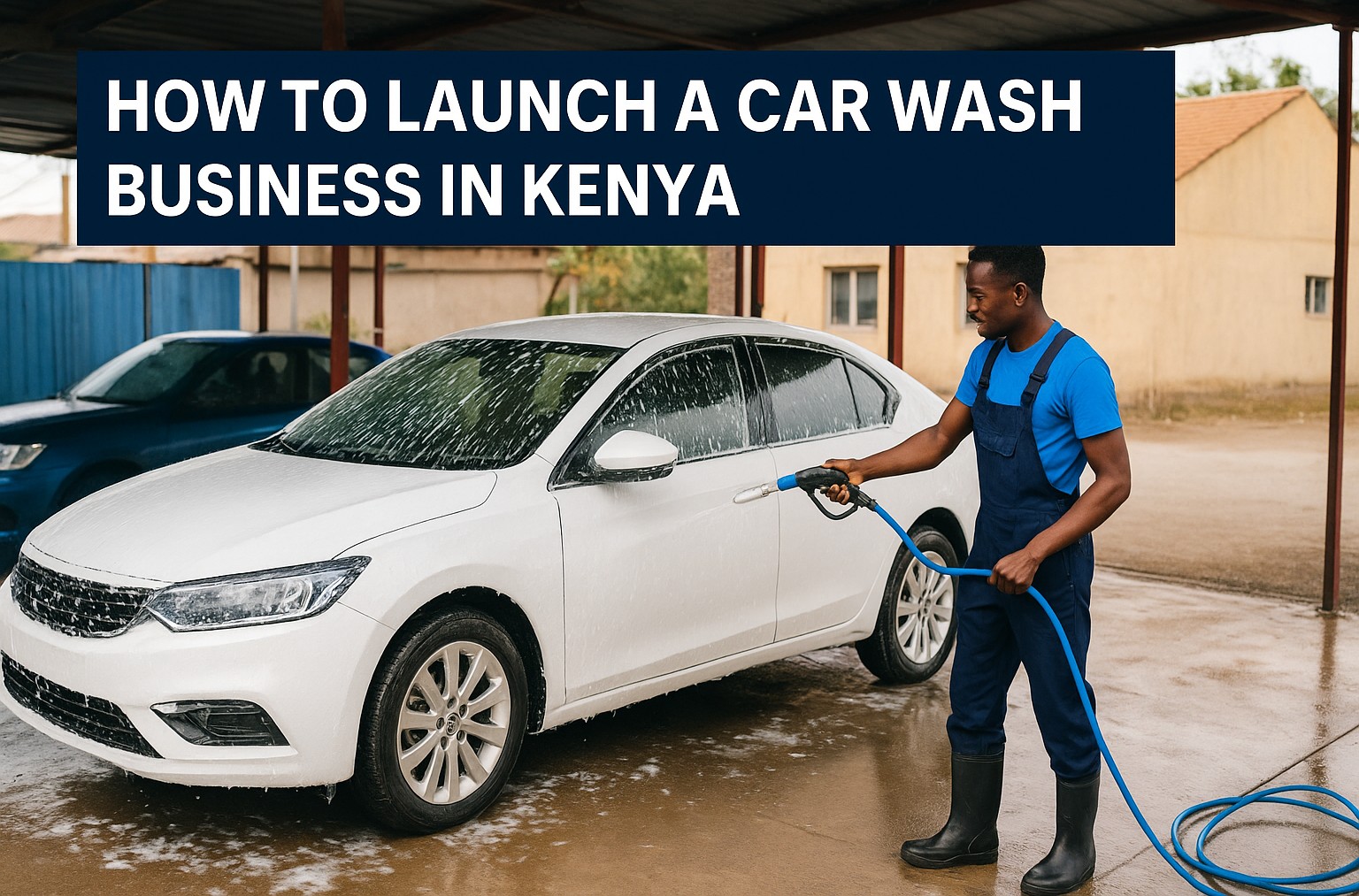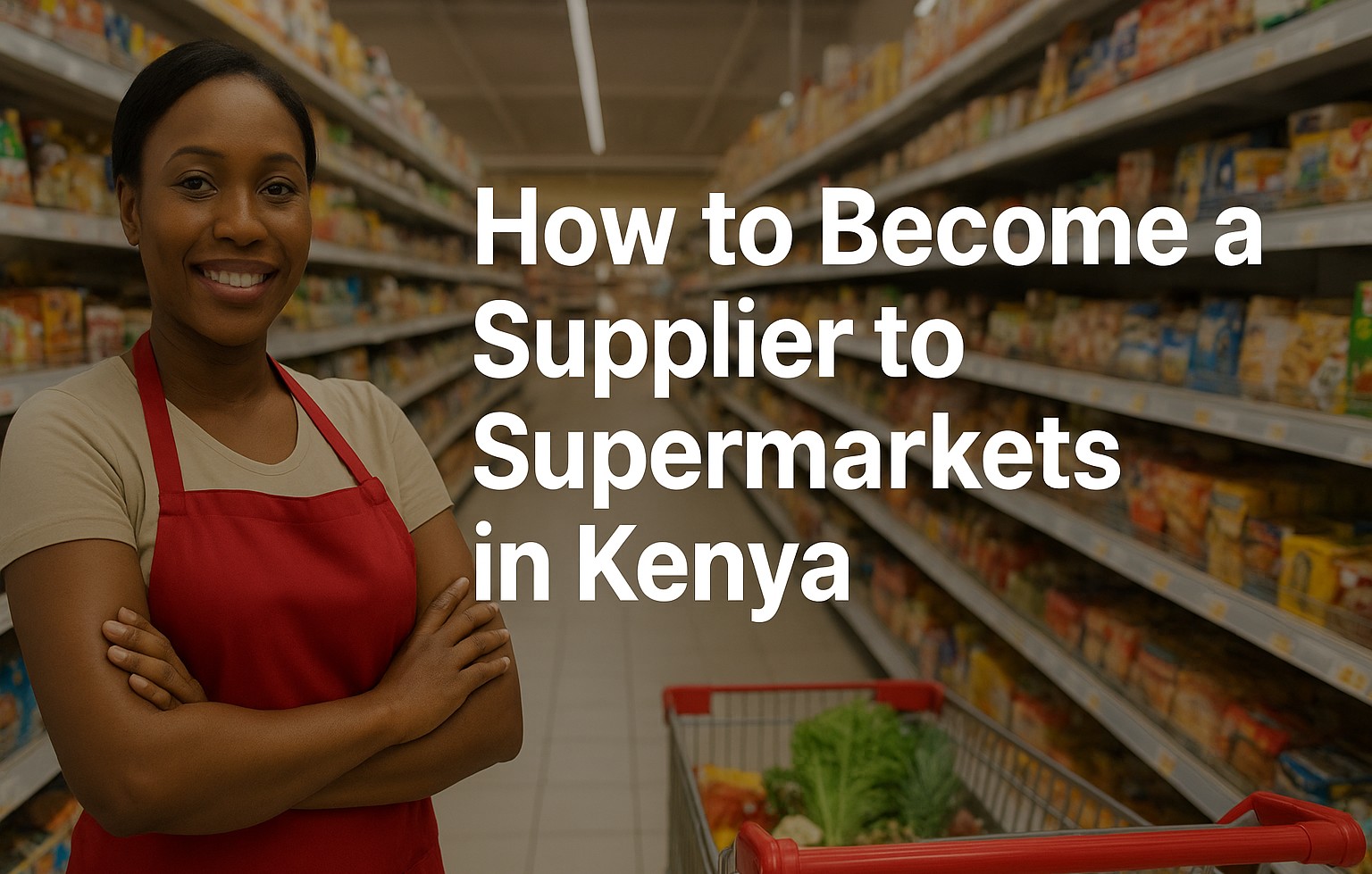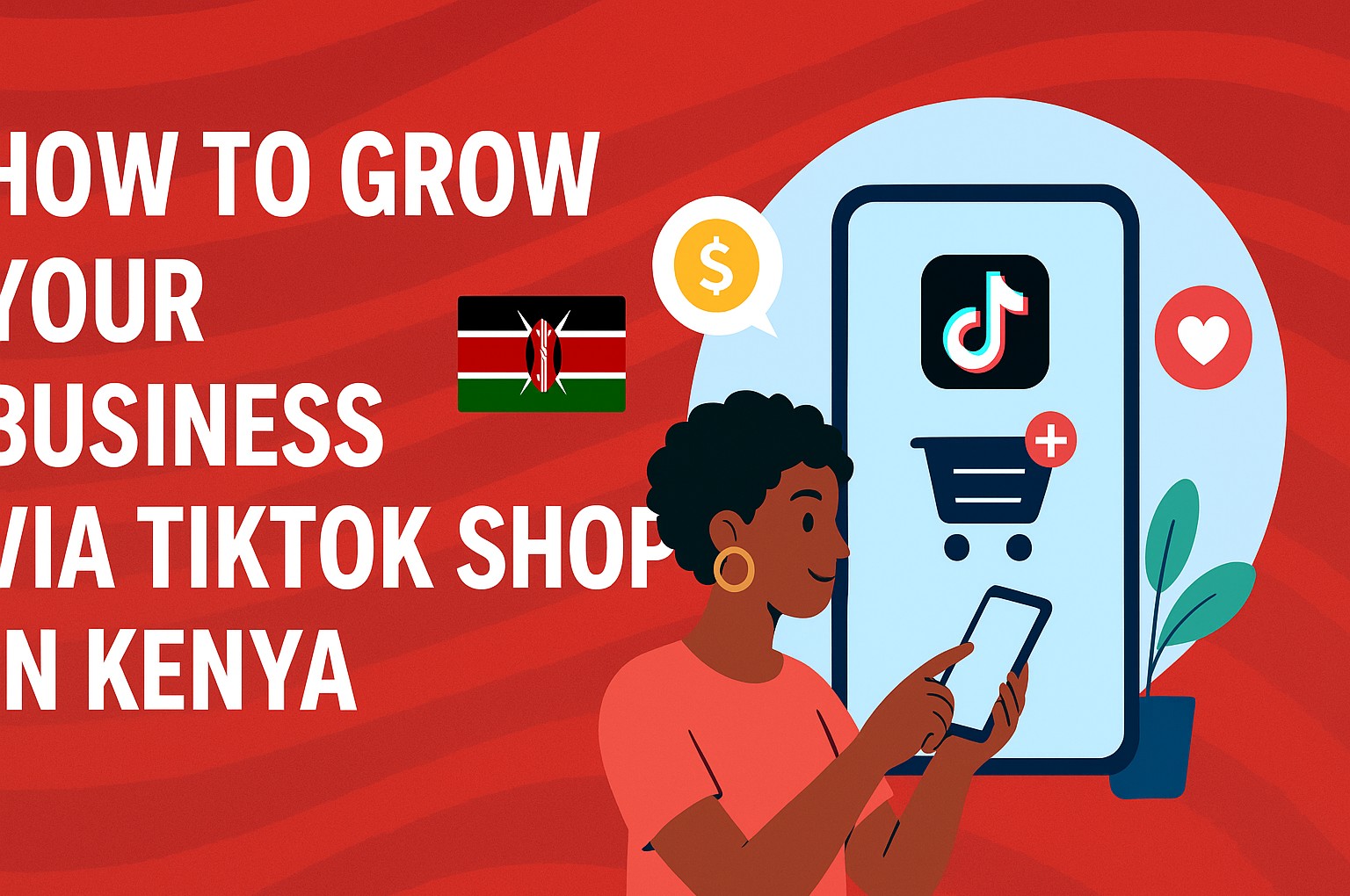

Titus Morebu
Author
How to Launch a Thriving Car Wash Business in Kenya (2025 Edition)
Step-by-step blueprint to start, license, equip & market a car wash in Kenya — maximize profits and SEO visibility.
🚗 Ready to turn soap and water into a profitable venture? In Kenya’s growing vehicle market, a well-run car wash can deliver healthy returns. But success demands more than buckets and rags. This guide walks you step by step — from research to launch to scaling — so your car wash business outshines the rest.
1. Why a Car Wash Business Makes Sense in Kenya
- Growing vehicle numbers: As urbanization and incomes rise, more Kenyans are owning and maintaining cars.
- High repeat demand: A car needs washing frequently — giving steady recurring business.
- Scalable model: You can start small (manual wash) and grow into detailing, automation, fleet contracts, or mobile wash.
- Value-added services: Beyond basic wash you can upsell interior cleaning, polishing, waxing, ceramic coating, headlight restoration.
2. Market Research & Validation
Know your target area & customers
Visit your proposed location(s) at various times. Note traffic volumes, existing car washes, pricing, quality, gaps. Talk to drivers, taxi operators, ride-share drivers, corporate fleets about what they currently use and what they’d want improved.
Competitive analysis
- Count how many direct competitors within 1–3 km radius
- List their services, pricing, quality, busiest hours
- Spot missing services (e.g. mobile wash, premium detailing, water recycling)
- Identify what could make your offering stand out — speed, convenience, eco solutions, loyalty programs
Estimate demand & revenue
Calculate potential throughput: e.g. if you wash 20 cars/day at KSh 300 average, that is KSh 6,000/day → ~KSh 180,000/month. Adjust for slow days. Some small car washes in Kenya report earnings between KSh 50,000 to 200,000 monthly depending on scale. (Ensure your projections are realistic and conservative.)
3. Choose a Business Model & Services
Manual / hand wash + vacuum (entry level)
Lowest capital. Requires labor, quality control, basic pressure wash, buckets, detergents.
Semi-automated / trolley wash
A powered trolley or sliding system that moves equipment along the car. Good middle ground.
Automatic / drive-through systems
High throughput, less manual labor, but heavy upfront cost and maintenance. Best suited for high-traffic locations. Some conveyor systems can wash 25–30 cars per hour in Kenya market models.
Detailing & premium services
Target higher-paying clients for interior cleaning, paint correction, coatings, upholstery, odor removal, headlight polishing, etc.
Mobile car wash
Bring services to homes, offices, events. Lower fixed cost, but logistics and water handling are key challenges.
4. Legal & Regulatory Compliance
Business registration & tax setup
Register your business (sole proprietorship, partnership or limited company) via the eCitizen portal. Get a KRA PIN and activate iTax. Register for NHIF/NSSF if you hire employees.
County business permit
Obtain a Single Business Permit from your county government. In many counties, the permit for a car wash may cost around KSh 12,000 annually (or more in major cities). Fire safety inspections are also common requirements.
Environmental & waste disposal compliance
Your operations must obey the Environmental Management and Coordination Act: you cannot discharge harmful pollutants or toxic chemicals into public drainage systems. Wastewater must comply with local discharge standards. You may need NEMA clearance or an EIA depending on scale.
Water abstraction & usage permits
If you will use boreholes or draw large water volumes, you may need a permit from the water authority. Avoid illegal abstraction.
Insurance & safety
- General liability insurance to cover damages to clients’ vehicles
- Property insurance for your equipment and premises
- Workers’ compensation / injury insurance for staff
- Safety protocols: non-slippery surfaces, safe electrical work, correct chemical handling
5. Location & Infrastructure Setup
Selecting a great site
- High visibility and foot/car traffic (near shopping centers, gas stations, office blocks, repair shops)
- Ease of access: wide entry, smooth drive-in/drive-out lanes
- Land size: ideally ≥100 m² to handle bays, customer waiting, expansion, parking
- Avoid obstacles such as poles, steep slopes, restricted access points
Design & layout essentials
- Proper drainage and wastewater catchment
- Concrete or paved surfaces
- Roofing or shade structures over wash bays
- Water storage tanks (e.g. 1,000 L+), booster pumps, pressure systems
- Three-phase power (if heavy machinery)
- Lighting for early/late hours
- Security: fencing, CCTV, gate
6. Equipment & Supplies
Essential equipment list
- High-pressure washers (electric or petrol-powered)
- Water pumps & plumbing
- Vacuum cleaners / suction devices
- Foamers, foam cannons, detailing tools
- Buffers, polishers, steam machines
- Consumables: biodegradable soaps, wax, glass cleaners, cloths, brushes
- Tanks, hoses, fittings, nozzles
- Water filtration / recycling unit (strong competitive advantage)
- POS / payment systems / card machines
Choosing the right machine type
Conveyor or touchless systems have high throughput but expensive per unit cost and maintenance. Trolley systems are more affordable but may limit scale. Many Kenya suppliers currently offer models suited for 8–30 cars/hour depending on configuration — choose based on your expected volume.
7. Staffing & Training
Hire reliable staff with integrity, good work ethic, and basic mechanical aptitude. Train them on:
- Proper washing techniques (avoid scratches, overpressure)
- Interior cleaning, detailing skills
- Customer service and upselling
- Equipment maintenance, safety, chemical handling
Create standard operating procedures (SOPs) for consistency, quality control checklists, and accountability tracking.
8. Pricing Strategy & Sales Channels
Basic pricing considerations
- Cost of water, detergents & consumables per car
- Labor cost per wash
- Depreciation and equipment maintenance
- Expected profit margin (aim for 20-50% markup)
- Competitive pricing benchmarking
Tiered packages & upsells
Offer tiered packages (basic, standard, premium). Upsells such as interior vacuum, tire dressing, engine cleaning, waxing, and ceramic coatings can increase average ticket value.
Corporate & fleet contracts
Reach out to taxi fleets, car rental agencies, ride-share operators for volume deals. These contracts provide steady income.
9. Marketing & Customer Acquisition
Online presence
- Simple website with service listing, location map, contact form
- Google My Business listing for local SEO
- Social media (Facebook, Instagram, TikTok): post before/after photos, promotions, videos
- Online ads targeting local area (Google Ads, Meta Ads)
Offline & local marketing
- Flyers and posters in nearby estates, offices, repair shops
- Signage on road, clear branding
- Partnerships with petrol stations, garages, auto parts shops
- Referral programs & loyalty cards
- Opening specials, discount days, package bundles
Customer retention
Email/SMS reminders, loyalty discounts, membership passes, excellent service and follow up feedback systems. Happy customers will refer others.
10. Operations & Financial Management
Daily operations
- Staff scheduling and shift management
- Inventory tracking of chemicals, consumables, parts
- Equipment maintenance schedule
- Water usage monitoring and recycling
- Cash handling and secure accounting
Budgeting & cash flow
Prepare monthly budgets, track revenue vs expenses, and maintain a buffer for repairs. Aim to break even within 6–12 months. Adjust pricing or add services if revenue is lagging.
Key performance indicators (KPIs)
- Cars washed per day
- Average revenue per car
- Consumable cost per car
- Labor cost ratio
- Net profit margin
- Customer retention rate and referrals
11. Sustainability & Innovation for Competitive Edge
- Water recycling and reuse: Installing filtration and recycling systems will drastically reduce water costs and environmental impact.
- Eco-friendly chemicals: Use biodegradable, phosphate-free detergents to comply with regulations and appeal to conscious customers.
- Solar power and energy efficiency: Use solar panels to reduce electricity bills, especially for pumps and lighting.
- Digital tools: Implement POS software, appointment booking apps, CRM for customer follow ups.
- Mobile extension: Grow into mobile or event-based car wash services to access new market segments.
12. Scaling Up & Growth Strategy
- Open additional branch locations once one is stable
- Franchise or license your brand to others
- Expand into premium detailing, ceramic coating, wrapping, window tinting
- Form partnerships with dealerships, insurance companies, auto fleets
- Offer subscription or membership models (e.g. monthly wash passes)
13. Common Challenges & Mitigation
- Water scarcity & cost: Mitigate via rainwater harvesting and recycling systems.
- High energy / utility costs: Use solar or energy-efficient pumps.
- Equipment breakdowns: Maintain spare parts stock and preventive maintenance.
- Regulatory changes: Stay updated with county and environmental laws.
- Competition saturation: Differentiate through quality, convenience, and unique services.
- Cash flow pressure: Avoid overextending capital, maintain reserves.
14. Step-by-Step Launch Timeline (First 3 Months)
- Weeks 1–2: Market research, site scouting, competitor visits
- Weeks 3–4: Business registration, permit applications, legal compliance
- Week 5: Site preparation, leveling, drainage, groundwork
- Week 6: Equipment installation, plumbing, electricals
- Week 7: Staff hiring and training, SOP setup
- Week 8: Soft launch — test operations, small client group
- Weeks 9–12: Full launch marketing push, fine tune operations, monitor KPIs
Conclusion
Starting a car wash business in Kenya offers excellent potential, but success hinges on planning, execution, regulatory compliance, and ongoing management. Choose your model carefully, invest intelligently in infrastructure and marketing, and build service excellence. As you scale and optimize, your car wash can become a lasting, profitable enterprise with a strong reputation in your community. 🚀
Gallery

Related Articles
3 articles
How to Become a Supplier to Supermarkets in Kenya – A Step-by-Step Guide 🌟
Learn how to register, pitch, and win supply contracts with Kenyan supermarkets. Step-by-step process, tips, and legal requirements — your roadmap to success.

Best Money-Saving Strategies for Kenyan Small Business Owners
Practical and actionable tips for small business owners in Kenya to cut costs, boost profits, and build resilience in 2025.

How to Grow Your Business via TikTok Shop in Kenya 🚀
Unlock TikTok Shop Kenya strategies to boost sales, visibility and customer trust with proven tactics for 2025 success.